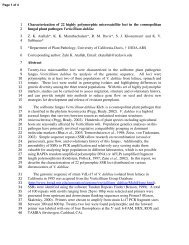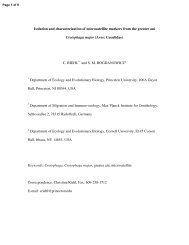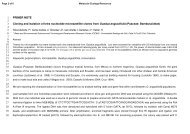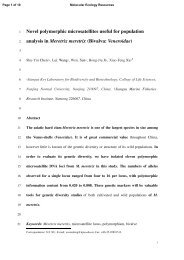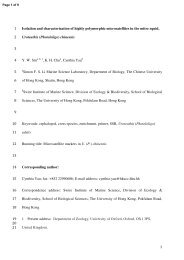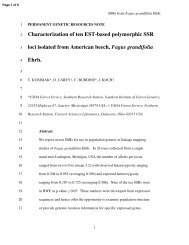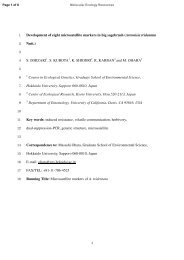Microsatellite loci for Palaearctic gudgeons - Molecular Ecology ...
Microsatellite loci for Palaearctic gudgeons - Molecular Ecology ...
Microsatellite loci for Palaearctic gudgeons - Molecular Ecology ...
You also want an ePaper? Increase the reach of your titles
YUMPU automatically turns print PDFs into web optimized ePapers that Google loves.
Page 1 of 9<br />
<strong>Molecular</strong> <strong>Ecology</strong> Resources<br />
<strong>Microsatellite</strong> <strong>loci</strong> <strong>for</strong> <strong>Palaearctic</strong> <strong>gudgeons</strong>: markers <strong>for</strong> identifying intergeneric<br />
hybrids between Romanogobio and Gobio<br />
Jan Mendel,* Ivo Papoušek,* Eva Marešová,* Lukáš Vetešník,* Karel Halačka,* Michał<br />
Nowak,† and Dagmar Čížková*<br />
*Institute of Vertebrate Biology, Academy of Sciences of the Czech Republic, v.v.i, Květná<br />
8, 60365 Brno, Czech Republic<br />
†University of Agriculture in Kraków, Spiczakowa 6, 30-199 Kraków-Mydlniki, Poland<br />
Keywords: Gobioninae, Romanogobio, endangered species, microsatellites<br />
Corresponding author: Jan Mendel, Květná 8, 603 65 Brno, Fax: +420 543 211 346; Email:<br />
jmendel@seznam.cz<br />
Running title: <strong>Microsatellite</strong>s <strong>for</strong> <strong>gudgeons</strong><br />
Abstract<br />
Six polymorphic microsatellite <strong>loci</strong> were isolated from the Danube whitefin gudgeon<br />
Romanogobio vladykovi. The number of alleles per locus varied from three to sixteen and the<br />
expected heterozygosities ranged from 0.404 – 0.897. In order to increase the number of<br />
microsatellite markers, five additional <strong>loci</strong> originally developed <strong>for</strong> Gobio gobio were<br />
successfully cross-amplified. The number of alleles per locus varied from two to fourteen.<br />
Their usefulness was confirmed by successful cross-amplification <strong>for</strong> 12 members of the<br />
gudgeon subfamily Gobioninae. The applicability of these markers was confirmed <strong>for</strong><br />
1
<strong>Molecular</strong> <strong>Ecology</strong> Resources<br />
Page 2 of 9<br />
intergeneric identification, discriminating between intergeneric hybrids and <strong>for</strong> population<br />
genetic investigations of endangered species from the genus Romanogobio.<br />
The representatives of the genus Romanogobio belong to the family Cyprinidae. This genus<br />
includes small freshwater fishes, collectively known as <strong>gudgeons</strong>, and contains many taxa that<br />
are endemic to various areas of Europe and Asia, as well as numerous threatened species.<br />
Our main motivation was based on a current study of <strong>gudgeons</strong> in the Eurasian context<br />
(Mendel 2007; Mendel et al. 2008) because the common distribution, the identical or very<br />
similar biological characteristics of these taxa, the considerable visual similarity, as well as<br />
the very frequent occurrence of hybridization events often lead to taxonomic confusion.<br />
Presently, a reliable morphological and molecular key is being intensively sought which<br />
would eliminate erroneous species identifications both in the field and in museum collections.<br />
Along with other factors, the non-existence of microsatellite markers is the reason <strong>for</strong><br />
insufficient knowledge of the status of populations of the disappearing and often threatened<br />
species of <strong>gudgeons</strong> in Europe, which hampers the establishment of suitable conservation<br />
measures. For example, according to the latest Red List of Lampreys and Fishes of the Czech<br />
Republic, the COUNCIL DIRECTIVE 92/43/EEC of 1992, and Order 166/2005 Coll., six<br />
Sites of Community Importance (SCIs) in the hydrographic system of the CR were announced<br />
<strong>for</strong> two <strong>gudgeons</strong> from the “kesslerii group” and “albipinnatus group” which are critically<br />
endangered or vulnerable. The Czech Republic proceeded to conduct their regular monitoring<br />
nevertheless, still without any knowledge of their genetic diversity.<br />
To develop microsatellite primers, we employed a modified enrichment protocol developed<br />
by Estoup & Martin (1996). Genomic (g) DNA was extracted (Genomic DNA Mini kit, KRD)<br />
from an ethanol-preserved fin of a single gudgeon collected in 2003 from the Dyje River<br />
2
Page 3 of 9<br />
<strong>Molecular</strong> <strong>Ecology</strong> Resources<br />
(Czech Republic). Total gDNA was digested with an RsaI restriction enzyme (Promega).<br />
Following the restriction digest, MluI oligo adaptors (RSA21 and phosphorylated RSA25) that<br />
serve as priming sites <strong>for</strong> the PCR were ligated onto the ends of gDNA fragments. Two<br />
biotinylated probes [dinucleotide (TG) 10 and tetranucleotide (ATCT) 5 ] were hybridized to the<br />
ligated DNA<br />
and selected using streptavidin magnetic particles (Promega). PCRs were<br />
per<strong>for</strong>med on the microsatellite-enriched eluate using one of the oligo adaptors (RsaI) as a<br />
primer. The amplification products were purified (QIAquick PCR Purification Kit, QIAGEN)<br />
and ligated into a plasmid vector (pGEM-T Easy Vector system II, Promega), trans<strong>for</strong>med<br />
into JM109 competent cells (Promega), and plated onto Luria-Bertani (LB) agar medium.<br />
Recombinant plasmids were identified by blue-white screening. Positive-trans<strong>for</strong>med cells<br />
were grown on LB agar, transferred onto Hybond-N + membranes (Amersham), screened<br />
using dioxigenin-end-labelled (TC) 10 and (ATCT) 5 probes (DIG Oligonucleotide Tailing Kit,<br />
Roche) and visualised using a DIG Nucleic Acid Detection Kit (Roche). We obtained 185<br />
positive clones from the two libraries and each clone was sequenced by Macrogen (South<br />
Korea). The sequences from 89 clones were of high quality and contained repeat regions. The<br />
primers were developed from flanking sequences using Oligo (Rychlik 2007). Successful<br />
amplifications with polymorphisms were detected with five unlabelled primer pairs based on<br />
PCR tests with 10 - 15 reference specimens. PCR conditions were optimized to produce clear<br />
bands on agarose gels and five <strong>loci</strong>-<strong>for</strong>ward primers were labelled with a fluorescent dye<br />
(Applied Biosystems; Table 1).<br />
PCRs were per<strong>for</strong>med on Mastercycler pro (Eppendorf) in a total volume of 10 µL using PPP<br />
Master Mix (Top-Bio) following the manufacturer’s protocol, 1 pmol of each primer and ~30<br />
ng of genomic DNA. The PCR consisted of an initial denaturation cycle of 95°C <strong>for</strong> 3 min; 35<br />
cycles at 95°C <strong>for</strong> 1 min; 50-60°C <strong>for</strong> 50 s (Table 1), elongation at 72°C <strong>for</strong> 60 s; and final<br />
3
<strong>Molecular</strong> <strong>Ecology</strong> Resources<br />
Page 4 of 9<br />
extension at 72°C <strong>for</strong> 10 min. The amplified products were diluted, of which 1 µL was added<br />
to 12 µL of <strong>for</strong>mamide and 500 LIZ Size Standard (Life Technologies) and electrophoresed<br />
by ABI PRISM 310 Genetic Analyzer (Applied Biosystems) using GENESCAN version 3.7.<br />
The conditions and characteristics of the <strong>loci</strong> are given in Table 1. We calculated the number<br />
of alleles per locus, observed and expected heterozygosities, the deviation from Hardy-<br />
Weinberg equilibrium and linkage disequilibrium expectations, and the frequency of null<br />
alleles using GENALEX 6 (Peakall & Smouse 2006), MICRO-CHECKER 2.2.3 (Van<br />
Oosterhout et al. 2004) and online version of GENEPOP 1.2 (Raymond & Rousset 1995).<br />
Our study developed six unique polymorphic dinucleotide microsatellite <strong>loci</strong> isolated from R.<br />
vladykovi (Rvla; Table 1). At the same time, using cross-species amplification we confirmed<br />
the applicability of these markers <strong>for</strong> 7 other species of the genus Romanogobio and 3 species<br />
of the genus Gobio. Two additional species of the genus Gobio (G. carpathicus and G.<br />
volgensis) were included in the analysis in order that the applicability of some <strong>loci</strong> <strong>for</strong> the<br />
easy identification of intergeneric hybrids and <strong>for</strong> the identification of both the genera might<br />
be reliably evaluated (Table 2).<br />
We evaluated the amplification patterns in 12 members of the gudgeon subfamily<br />
Gobioninae, including R. vladykovi (Dyje River, Czech Republic), R. belingi (Sluch River,<br />
Ukraine), R. albipinnatus (Moksha River, Russia), R. parvus (Kuban River, Russia), R.<br />
pentatrichus (Kuban River, Russia), R. uranoscopus (Ulička River, Slovakia), R. kesslerii<br />
(San River, Poland), R. banaticus (Bečva River, Czech Republic), G. gobio (Elbe River,<br />
Czech Republic), G. obtusirostris (Váh River, Slovakia), Gobio sp. 1 (Topľa River, Slovakia),<br />
G. carpathicus (Laborec River, Slovakia), G. volgensis (Bol’shaya Lašva River, Russia).<br />
Prior to this, all species had been both morphologically and molecularly identified (Mendel<br />
2007; Mendel et al. 2008).<br />
4
Page 5 of 9<br />
<strong>Molecular</strong> <strong>Ecology</strong> Resources<br />
The microsatellite <strong>loci</strong> in R. vladykovi revealed both moderate (Rvla22114-I, Rvla22114-II,<br />
Rvla22211) and high genetic variation (Rvla21030, Rvla21177, Rvla21144). Genotypes of fin<br />
samples from the natural population (Dyje River) showed polymorphisms with three to<br />
sixteen alleles per locus among 21 - 23 individuals. Most <strong>loci</strong> were at Hardy-Weinberg<br />
equilibrium, except <strong>for</strong> Rvla22211, which showed a significant excess of homozygotes,<br />
possibly caused by the presence of null alleles. Most <strong>loci</strong> were unlinked, except <strong>for</strong><br />
Rvla22114 (based on MICRO-CHECKER results, see Table 1).<br />
In order to supplement the design of microsatellite panel <strong>for</strong> the genus Romanogobio, we<br />
proved the usefulness of additional five <strong>loci</strong> (Gob3, Gob12, Gob15, Gob22, Gob28) from the<br />
microsatellite library of G. gobio (Knapen et al. 2006). The microsatellite <strong>loci</strong> in R. vladykovi<br />
revealed both low (Gob15) and high genetic variation (Gob3, Gob12, Gob22, Gob28), with<br />
two to fourteen alleles per locus among 20 - 27 individuals. Most <strong>loci</strong> were at Hardy-<br />
Weinberg equilibrium, except <strong>for</strong> Gob3, similarly as in Knapen et al. (2006), possibly caused<br />
by the presence of null alleles (Table 1).<br />
Table 2 provides cross-species amplification results <strong>for</strong> 10 - 12 species from both the genera.<br />
From the 11 primer pairs cross-amplified in this study, 6 presented here and 5 from Knapen et<br />
al. 2006, seven resulted in an amplified PCR product <strong>for</strong> all the tested species and three <strong>for</strong><br />
the eight, nine resp. eleven species.<br />
The detected allele length and chosen combination of fluorescent labelling enables the<br />
employment of the entire developed panel of 11 microsatellite <strong>loci</strong> in a multiplex PCR<br />
analysis.<br />
Two <strong>loci</strong>, Rvla22114_II (A) and Rvla22211 (B), proved to be more suitable <strong>for</strong> generic<br />
identification and <strong>for</strong> easier detection of intergeneric hybridization events. Locus A exhibited<br />
the generic alleles within 196 - 202 bp <strong>for</strong> Romanogobio and within 308 - 338 bp <strong>for</strong> Gobio.<br />
5
<strong>Molecular</strong> <strong>Ecology</strong> Resources<br />
Page 6 of 9<br />
For Romanogobio, locus B exhibited the generic alleles within 152 and 154 bp, always in the<br />
homozygotic <strong>for</strong>m, while the second allele did not amplify. For the representatives of the<br />
genus Gobio and the intergeneric hybrids, the alleles 146 or 148 bp were always attached,<br />
<strong>for</strong>ming a heterozygotic pattern. This was true <strong>for</strong> all tested species except R. pentatrichus.<br />
Furthermore, <strong>loci</strong> Gob15, Gob22 and Gob28 also appear to be potentially interesting <strong>for</strong><br />
hybrid identification and taxonomical purposes. Further analyses of a greater number of<br />
specimens from the individual species will be required <strong>for</strong> the evaluation of the applicability<br />
of the developed <strong>loci</strong>.<br />
In conclusion, our study suggests that these <strong>loci</strong> may be helpful <strong>for</strong> intergeneric identification,<br />
<strong>for</strong> the discrimination of intergeneric hybrids and <strong>for</strong> population genetic investigations of<br />
disappearing and endangered species of the genus Romanogobio.<br />
Acknowledgements<br />
This study was carried out within the framework of research project 206/09/P608 supported<br />
by the Grant Agency of the Czech Republic. We are thankful to E. D. Vasileva, J. Koščo <strong>for</strong><br />
their help with obtaining the samples.<br />
References<br />
Estoup A, Martin O (1996) Marqueurs microsatellites: isolement a`l’aide de sondes non<br />
radioactives, caracte´risation et mise au point. Personal communication, protocols available in<br />
the web at http://www.agroparistech.fr/svs/genere/microsat/microsat.htm.<br />
Knapen D, Taylor MI, Blust R, Verheyen E (2006) Isolation and charakterization of<br />
polymorphic<br />
microsatellite <strong>loci</strong> in the gudgeon, Gobio gobio (Cyprinidae). <strong>Molecular</strong><br />
<strong>Ecology</strong> Notes, 6, 387-389.<br />
6
Page 7 of 9<br />
<strong>Molecular</strong> <strong>Ecology</strong> Resources<br />
Mendel J (2007) The using of mtDNA <strong>for</strong> characteristics of population structures of species<br />
from the genera Gobio and Romanogobio. Thesis, Brno, 203pp. (in Czech with English<br />
summary)<br />
Mendel J, Lusk S, Vasil'eva ED, Vasil'ev VP, Lusková V, Ekmekci FG, Erk'kan F, Ruchin A,<br />
Koščo J, Vetešník L, Halačka K, Šanda R, Pashkov AN, Reshetnikov SI (2008) <strong>Molecular</strong><br />
phylogeny of the genus Gobio Cuvier, 1816 (Teleostei: Cyprinidae) and its contribution to<br />
taxonomy. <strong>Molecular</strong> Phylogenetics and Evolution, 47, 1061-1075.<br />
Peakall R, Smouse PE (2006) Genalex 6: genetic analysis in Excel. Population genetic<br />
software <strong>for</strong> teaching and research. <strong>Molecular</strong> <strong>Ecology</strong> Notes, 6, 288-295.<br />
Raymond M, Rousset F (1995) Genepop (version 1.2): population genetics software <strong>for</strong> exact<br />
tests and ecumenicism. Journal of Heredity, 86, 248-249.<br />
Rychlik W (2007) Oligo 7 primer analysis software. In: Yuryev A(ed). Methods in molecular<br />
biology vol. 402: PCR primer design. Humana Press Inc., Totowa, pp 35–59.<br />
Van Oosterhout C, Hutchinson WF, Wills DPM, Shipley P (2004) Micro-checker: software<br />
<strong>for</strong> identifying and correcting genotyping errors in microsatellite data. <strong>Molecular</strong> <strong>Ecology</strong><br />
Notes, 4, 535-538.<br />
Data accessibility<br />
Data sequences: Genbank accessions: DQ207799, DQ207801, DQ207802, DQ207804,<br />
DQ207805, JQ993103 - JQ993107.<br />
7
<strong>Molecular</strong> <strong>Ecology</strong> Resources<br />
Page 8 of 9<br />
Table 1 Characteristics of six microsatellite <strong>loci</strong> isolated from Romanogobio vladykovi and five <strong>loci</strong> prepared from cross-species<br />
amplification<br />
Locus Repeat motif Primer sequence Size (bp) N N a H O/H E P-value Dye Null freq. T a (°C)<br />
Rvla21144 (AC) 2(ACTC) 3(AC) 8 CGG TTG ATG AGT TCG CTG TAG 269-287 21 8 0.571/0.760 NS VIC 0.107 60<br />
GTC ACA TGA TCC TCG TTT GG<br />
Rvla21177 (TG) 11 CTG ACT ACA CAT GGT TAA CGC 210-258 21 14 0.900/0.897 NS 6-FAM 0.024 54<br />
CGG CTG CTT TAA TGT CCA C<br />
Rvla22114-I (TG) 10 CGG CTT CCC ATA GTA AAC 142-146 23 3 0.364/0.404 NS VIC 0.031 53<br />
GTT AGG CCT GGA GTC AAT G<br />
Rvla22114-II (AC) 13GC(AC) 22 CGG CTT CCC ATA GTA AAC 196-200 21 3 0.762/0.618 NS VIC 0 53<br />
GTT AGG CCT GGA GTC AAT G<br />
Rvla22211 (CA) 14 GCA AAC CGT ATT TTC TAT CCC 152-156 23 3 0/0.541* ‡ NED 0.350 52<br />
GTG AAA TAT GAG GAC GTT CCC<br />
Rvla21030 (CA) 11AA(CT) 18 CTT CTG ATT TAA TGT TAG GGT 82-120 23 16 0.773/0.888 NS 6-FAM 0.083 50<br />
TCC CAA TGA CGT GAT AGA G<br />
Gob3 † (GA) 18 ACT CTG CCC ACA GTC ACT CG 182-212 25 11 0.320/0.847 ‡ NED 0.285 58<br />
TGA AAT GTT TTC CTC AAA AAC G<br />
Gob12 † (CA) 7AA(CA) 19 AAG GAA ATG CAG AAT CAC AAA ATT AC 165-197 20 9 0.650/0.860 NS 6-FAM 0.113 62<br />
GAA CTT GCA AAA TAG CAG GGT G<br />
Gob15 † (CA) 10 TGT CCA CGT TCT GGT CAC AG 135-137 22 2 0.318/0.499 NS 6-FAM 0.121 57<br />
CTT TAA ATG TTA TTT GGT CTT TGC AG<br />
Gob22 † (CA) 9N 18(CA) 10 GAT TGC CAT GGT TAC CGA AT 200-246 27 14 0.704/0.838 NS PET 0.073 58<br />
TCT CCA CCT CGA AAT CAT CC<br />
Gob28 † (GT) 9(GA) 4(GT) 3 CGC ACA AAC AGC TCA GAC TC 216-234 26 10 0.769/0.848 NS VIC 0.042 60<br />
CGGTATGTACAAGCCAGATGAA<br />
N, number of analyzed specimens; Na, number of alleles; H O /H E , average observed/expected heterozygosities; P value <strong>for</strong> Hardy-Weinberg<br />
Equilibrium; Dye, 5' fluorescent label; Null freq., frequency of null alleles; Ta, annealing temperature; *all individuals were homozygotes;<br />
‡indicates significant departure from HWE (P < 0.05); †indicates homologous cross-species amplified <strong>loci</strong><br />
8
Page 9 of 9<br />
<strong>Molecular</strong> <strong>Ecology</strong> Resources<br />
Table 2 Characteristics of eleven microsatellite <strong>loci</strong> <strong>for</strong> the fish subfamily Gobioninae<br />
R. belingi R. albipinnatus R. parvus R. uranoscopus R. banaticus R. kesslerii R. pentatrichus<br />
Locus N/N a Size (bp) N/N a Size (bp) N/N a Size (bp) N/N a Size (bp) N/N a Size (bp) N/N a Size (bp) N/N a Size (bp)<br />
Rvla21144 3/3 277-287 4/6 269-289 2/3 271-287 4/3 279-291 3/7 273-289 5/4 273-319 1/1 271<br />
Rvla21177 3/4 228-256 4/5 210-234 2/4 218-308 4/5 210-250 3/7 212-262 5/7 214-240 1/2 216-224<br />
Rvla22114_I 2/1 144 4/3 142-146 2/1 144 4/1 144 3/1 144 5/1 146 1/1 146<br />
Rvla22114_II 3/2 196-200 4/2 196-202 2/1 196 4/1 200 3/3 196-200 4/2 198-202 1/- -<br />
Rvla22211 3/1 154 4/1 154 1/1 154 4/1 154 3/2 152-154 5/1 154 1/2 146-154<br />
Rvla21030 2/4 84-96 4/4 74-92 2/3 74-102 3/5 118-136 1/2 86-94 3/3 88-94 1/1 84<br />
Gob3 4/2 171-193 2/1 172 2/- - 2/3 205-221 2/2 163-165 2/- - 2/4 212-238<br />
Gob12 4/4 173-183 2/2 151-154 2/2 151-154 2/2 151-162 2/2 149-163 2/2 138-150 2/2 150-157<br />
Gob15 4/2 137-139 2/2 138-140 2/3 138-142 2/1 138 2/2 138-150 2/3 171-183 2/2 140-146<br />
Gob22 4/3 210-232 2/3 267-293 2/4 226-286 2/4 224-254 2/2 200-202 2/2 181-183 2/1 178<br />
Gob28 4/4 222-228 2/2 222-234 2/3 214-230 2/2 212-224 2/3 208-240 2/2 236-244 2/2 226-228<br />
N, number of analyzed specimens; N a , number of alleles; NA, locus did not analyze; -, locus did not amplify; *, Knapen et al., 2006.<br />
Table 2 Continued<br />
G. gobio G. obtusirostris Gobio sp. 1 G. carpathicus G. volgensis<br />
Locus N/N a Size (bp) N/N a Size (bp) N/N a Size (bp) N/N a Size (bp) N/N a Size (bp)<br />
Rvla21144 7/8 275-291 2/4 267-283 1/2 269-287 NA NA NA NA<br />
Rvla21177 7/6 214-234 2/3 212-230 1/2 220-254 NA NA NA NA<br />
Rvla22114_I 5/2 144-146 1/1 144 1/- - NA NA NA NA<br />
Rvla22114_II 7/5 308-338 4/5 312-324 1/1 338 3/1 338 2/2 314-324<br />
Rvla22211 8/4 146-154 2/2 146-154 1/2 146-154 2/2 146-154 2/4 146-154<br />
Rvla21030 4/3 96-112 2/- - 1/1 106 NA NA NA NA<br />
Gob3 82/12 163-208* 2/2 181-187 2/2 168-204 NA NA NA NA<br />
Gob12 82/13 188-214* 2/3 178-186 2/2 115-151 NA NA NA NA<br />
Gob15 82/5 139-154* 2/3 144-161 2/3 142-153 NA NA NA NA<br />
Gob22 82/7 179-203* 2/3 185-191 2/3 183-195 NA NA NA NA<br />
Gob28 82/6 190-202* 2/3 209-215 2/2 212-216 NA NA NA NA<br />
9




